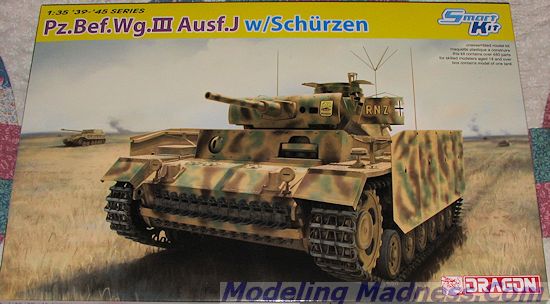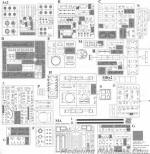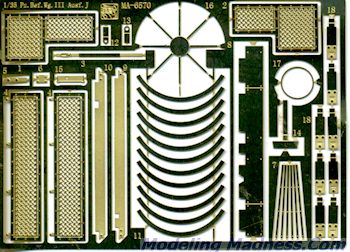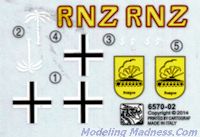
Dragon 1/35 Pz.Bef.Wg.III ausf J
| KIT #: | 6570 |
| PRICE: |
$ |
| DECALS: | Two options |
| REVIEWER: | Scott Van Aken |
| NOTES: |
Smart Kit |

| HISTORY |
On January 11, 1934, following specifications laid down by Heinz Guderian, the Army Weapons Department drew up plans for a medium tank with a maximum weight of 24,000 kg and a top speed of 35 km/h. It was intended as the main tank of the German Panzer divisions, capable of engaging and destroying opposing tank forces.
Daimler-Benz, Krupp, MAN, and Rheinmetall all produced prototypes. Testing of the prototypes took place in 1936 and 1937, leading to the Daimler-Benz design being chosen for production. The first Panzer III A came off the assembly line in May of 1937, and a total of ten, two of which were unarmed, were produced in 1937. Mass production of the tank, then in model III F, began in 1939.
Between 1937 and 1940, attempts were made to standardize parts between Krupp's Panzer IV and Daimler-Benz's Panzer III.
Much of the early development work on the Panzer III was a quest for a suitable suspension. Several varieties of leaf-spring suspensions were tried on Ausf A through D before the torsion-bar suspension of the Ausf E was standardized. The Panzer III, along with the Soviet KV heavy tank, was one of the first tanks to use this suspension design.
The Panzer III was intended as the main battle tank of the German forces. It outclassed most of the tanks of the time However, when it initially met the Soviet KV and T-34 tank designs it proved to be inferior. To meet the growing need to counter the T-34 the Panzer III was upgunned with the 50mm KwK 39 L/60 and received more armor which made it a very formidable opponent for the T-34. This still failed to address the problem caused by the KV tanks though, so in 1942, several self propelled guns as well as the longer barreled 75mm Kwk 40 L/43 Panzer IV Ausf F2 and the Panzer IV Ausf G were developed and produced.
In 1942, the Ausf N model of the Panzer III was created with an L/24 75 mm gun, a low-velocity gun designed for anti-infantry and close-support work. For defensive purposes however, it did carry a few rounds of hollow charge ammunition which could penetrate 70-100mm of armor depending on the round's variant but these were strictly used for self-defensive purposes.
When compared to the earlier variants, the Panzer III Ausf J, the subject of this kit, had a longer/more effective 5 cm KwK 39 L/60 gun. This is the variant that was developed in response to the T-34 that was met in Russia. In North Africa, the earlier versions were more than a match for British tanks, but once the US Sherman was introduced at El Alamein, some were sent to the Afrika Korps as well. 1067 produced in late 1941 to mid 1942.
Some of those tanks were turned into command tanks with additional radio equipment. Generally those tanks did not have the machine gun installed and some had fake main gun barrels.
| THE KIT |
 Dragon
prides itself in producing what they think are the most accurate armor kits
around. The sheer number of kits and the high quality of their molding have made
them probably the most popular armor kit company around. Even more so than
Tamiya for many as much due to the quality and detail provided as to their
competitive pricing.
Dragon
prides itself in producing what they think are the most accurate armor kits
around. The sheer number of kits and the high quality of their molding have made
them probably the most popular armor kit company around. Even more so than
Tamiya for many as much due to the quality and detail provided as to their
competitive pricing.
This kit is no exception to that. Thanks to heavy
investment into 'slide molding' technology, the ability to produce complex
shapes with little or no mold seams has really put them in the front of the
molding industry. The results of this technology that are immediately visible to
most are things like hollowe d out ends of gun barrels and exhaust.
d out ends of gun barrels and exhaust.
This kit is pretty much the same as their standard ausf J of several years back. However, there are differences. One is the inclusion of DS tracks in lieu of the individual track links. Another is the addition of the various bits for the radio and that includes the external antenna that readily identifies command tanks.
Without further ado, here is a list of features from the Dragon PR folks

 There are
four markings options provided in the instructions. Most are a base of panzer
tan. First is with z.Pg.Jg.Rgt.656 in 1943 and is shown on the box art. Second
and third are unidentified units in Russia during 1943, one in a winter wash.
The final option is a desert tan vehicle from Pz.Rgt.7 during the last days of
the North Africa campaign in 1943.
There are
four markings options provided in the instructions. Most are a base of panzer
tan. First is with z.Pg.Jg.Rgt.656 in 1943 and is shown on the box art. Second
and third are unidentified units in Russia during 1943, one in a winter wash.
The final option is a desert tan vehicle from Pz.Rgt.7 during the last days of
the North Africa campaign in 1943.
| CONCLUSIONS |
| REFERENCES |
http://en.wikipedia.org/wiki/Panzer_III
August 2014 Thanks to
www.dragonmodelsusa.com for the preview kit. Get yours
today at your local shop or on-line retailer. If you would like your product reviewed fairly and fairly quickly, please contact the editor or see other details in the
Note to
Contributors.